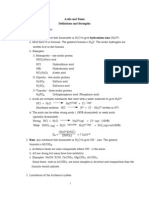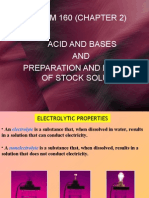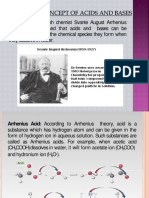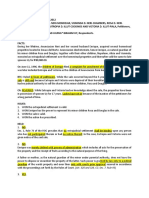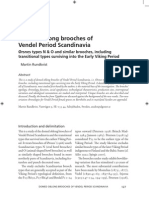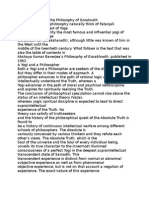Chem 1101: Chemistry (Eee/Coe)
Chem 1101: Chemistry (Eee/Coe)
Uploaded by
Ferdous FaridiCopyright:
Available Formats
Chem 1101: Chemistry (Eee/Coe)
Chem 1101: Chemistry (Eee/Coe)
Uploaded by
Ferdous FaridiOriginal Title
Copyright
Available Formats
Share this document
Did you find this document useful?
Is this content inappropriate?
Copyright:
Available Formats
Chem 1101: Chemistry (Eee/Coe)
Chem 1101: Chemistry (Eee/Coe)
Uploaded by
Ferdous FaridiCopyright:
Available Formats
CHEM 1101: CHEMISTRY
(EEE/CoE)
LECTURE 8
ACIDS AND BASES Properties of Acids
taste sour (don't taste them!)... the word 'acid' comes from the Latin acere, which means 'sour' acids change litmus (a blue vegetable dye) from blue to red their aqueous (water) solutions conduct electric current (are electrolytes) react with bases to form salts and water evolve hydrogen gas (H2) upon reaction with an active metal (such as alkali metals, alkaline earth metals, zinc, aluminum)
Properties of Bases
taste bitter (don't taste them!) feel slippery or soapy (don't arbitrarily touch them!) bases don't change the color of litmus; they can turn red (acidified) litmus back to blue their aqueous (water) solutions conduct and electric current (are electrolytes) react with acids to form salts and water
Examples of Common Acids
citric acid (from certain fruits and veggies, notably citrus fruits) ascorbic acid (vitamin C, as from certain fruits) vinegar (5% acetic acid) carbonic acid (for carbonation of soft drinks) lactic acid (in buttermilk) Mineral acids like HCl, HNO3, H2SO4 etc
Examples of Common Bases
Caustic soda or lye (NaOH) Caustic potash (KOH) household ammonia (aqueous) [NH3]
BASE VS ALKALI Bases: Bases are metal oxides, hydroxides or compounds (such as NH3) that give OH- ions in aqueous solution. CuO (s) + 2HCl (aq.) CuCl2 (aq.) + H2O (l) NaOH (s) + HCl (aq.) NaCl (aq.) + H2O (l) H+ + OH- H2O NH3 (g) + H2O (l) NH4+ (aq.) + OHAlkali: A base that dissolves in H2O to give OH- ions is called an alkali. NH3, NaOH are examples.
Acids and Bases (Updated on May 15, 2011) Page 1
CHEM 1101: CHEMISTRY
(EEE/CoE)
LECTURE 8
All alkali are base, but all bases are not alkali. Strong and Weak Acids and Bases Strong Acids A strong acid is an acid which is fully ionised in solution. Strong acids are so fully ionised in solution (close to 100%, but not quite) that the equilibrium constant has very large values much greater than one million. e.g. HCl(aq) + H2O(l) H3O+(aq) + Cl-(aq) Greater than 99.99% ionised
There aren't very many strong acids, which makes life very easy for you. Strong Acids Sulphuric acid Hydrochloric acid Hybrobromic acid Hydroiodic acid Nitric acid Perchloric acid The Formulae H2SO4 HCl HBr HI HNO3 HClO4
Weak Acids A weak acid is an acid which is only partially ionised in solution. This also means that it has a small value for the equilibrium constant for the ionisation reaction. The value tends to be less than one, and quite a lot less than one. e.g. CH3COOH(aq) + H2O(l) Strong Bases Similarly, a strong base is one which is fully ionised in solution. It also has a high value for the equilibrium constant for ionisation. Again there are not many of them, and again you can memorise them all. Strong Bases Lithium hydroxide
Acids and Bases (Updated on May 15, 2011)
H3O+(aq) + CH3COO-(aq) Less than 0.4% ionised.
The Formulae LiOH
Page 2
CHEM 1101: CHEMISTRY
(EEE/CoE)
LECTURE 8
Sodium hydroxide Potassium hydroxide Rubidium hydroxide Caesium hydroxide Barium hydroxide Calcium hydroxide Strontium hydroxide
NaOH KOH RbOH CsOH Ba(OH)2 Ca(OH)2 Sr(OH)2
Weak Bases Again, anything else is automatically a weak base. As before, this means that they have a small value for the equilibrium constant for ionisation. Again, there is no reference to the concentration of the solution, or how corrosive it is. ================================================================== Three concept of acids and bases are: (1) Arrhenius concept (2) Bronsted-Lowry concept (3) Lewis concept Arrhenius concept (1884): An acid is a compound that releases H+ ions in H2O. A base is a compound that releases OH- ions in H2O. HCl + H2O H3O+ + ClNaOH + H2O Na+ + OHUsefulness: This concept is useful in the study of chemical reactions. Limitations: (a) Free H+ and OH- ions do not exist in water.
.. O: + H .. O H Hydronium ion + H or H3O+
H Acids and Bases (Updated on May 15, 2011)
Page 3
CHEM 1101: CHEMISTRY
(EEE/CoE)
LECTURE 8
(b) Limited to water only. These definitions are applicable to water only. (c) Some bases do not contain OH-. Example: NH3, CaO Bronsted-Lowry concept (1923): An acid is any molecule or ion that can donate a proton (H+). A base is any molecule or ion that can accept a proton (H+).
+ H ACID .. N H base acid BASE H H + H Cl H N H H + or Cl-
CaO
O H
Ca(OH)2
base
acid
Bronsted-Lowry concept is superior to Arrhenius concept: (a) Much wider scope. (b) Not limited to aqueous solutions. NH3 + HCl NH4+ + Cl-
(c) Release of OH- not necessary to qualify as a base. NH3 + H+ base NH4+ acid
An acid is a proton donor, while a base is a proton acceptor. Conjugate acid and base: In acid-base reaction the acid gives up its proton and produces a new base.
Acids and Bases (Updated on May 15, 2011) Page 4
CHEM 1101: CHEMISTRY
(EEE/CoE)
LECTURE 8
Conjugate pair HA acid + Bbase HB Conjugate acid Conjugate pair + AConjugate base
The new base (A-) that is related to the original acid (HA) is called a conjugate base. Similarly, the original base (B-) after a accepting a proton becomes a new acid is called a conjugate acid. Conjugate pair: The acid-base pairs associated with the loss or gain of proton is a called conjugates pair. In any acid-base reaction, there are two conjugate acid-base pairs. For example, HA and A-, HB and B-.
H+ H+ HCl acid NH4+ Conj. acid H+ H+ ClConj. base
NH3 base
A weak acid has a strong conjugate base. A weak base has a strong conjugate acid.
Conjugate pair CH3COOH weak acid + H2O weak base H3O+ stronger acid + CH3COOstronger base
Conjugate pair
A strong acid has a weak conjugate base. A strong base has a weak conjugate acid.
Conjugate pair H2O strong Acids and Bases (Updated on Maystrong 15, 2011) acid base HCl + H3O+ weak acid + Ciweak base
Page 5
Conjugate pair
CHEM 1101: CHEMISTRY
(EEE/CoE)
LECTURE 8
Conjugate acid and base of H2O and HCO3-:
-H+ H2O +H+ H3O+ conjugate acid of H2O CO3-2 conjugate base of HCO3OHconjugate base of H2O
-H+ HCO3+H+
H2CO3
conjugate acid of HCO3-
Classes of Bronsted Acids and Bases: Bronsted acids: (1) Monoprotic acids- donate one proton HF H+ + F-, CH3COOH CH3COO- + H+ (2) Polyprotic acids-donate two or more protons H2S 2H+ + S2-, C2O4H2 C2O42- + 2H+ Bronsted bases: (1) Monoprotic bases- accept one proton HS- + H+ H2S, H2O + H+ H3O+ (2) Polyprotic bases- accept two or more protons SO42- + 2H+ H2SO4, PO43- + 3H+ H3PO4+ Amphiprotic substances: Molecule or ions that behave both as Bronsted acid and base. For example, H2O.
HCl acid NH3 base + + H2O base H2O acid NH4+ + OHH3O+ + Cl-
Lewis concept (1930): An acid is an electron-pair acceptor.
Acids and Bases (Updated on May 15, 2011) Page 6
CHEM 1101: CHEMISTRY
(EEE/CoE)
LECTURE 8
A base is an electron-pair donor.
A Lewis acid
:B Lewis base
Complex
The combination of Lewis acid and Lewis base is called a complex. All cations or molecules short of an electron pair act as Lewis acids; and all anions or molecules having a lone pair of electron act as Lewis bases. Examples: (a)
H+ + H Lewis acid Lewis base .. N H .. :O .. H + :N H H F .. O .. F B F Complex H H H N H H
(b)
H+ F
H H N H H
(c)
B F
Factors that are responsible for the strength of acids and bases (1) Base LiOH NaOH KOH CsOH Mg(OH)2 Size of metal ions: Size of metal ion () 0.60 0.95 1.33 1.69 0.65
Charge of ion +1 +1 +1 +1 +2
Qualitative strength
Weak base Strong base Very strong base Strongest base Weaker base Weaker base Al(OH)3 0.50 +3 (amphoteric) (2) Ionization constant: The smaller the value of ionization constant (K), the less is the degree of ionization and hence less strong the acids (or bases). H3PO4 H+ + H2PO4 1 [ H + ][ H 2 PO4 ] K= = 0.75 10-2 [ H 3 PO4 ]
1
Acids and Bases (Updated on May 15, 2011)
Page 7
CHEM 1101: CHEMISTRY
(EEE/CoE)
LECTURE 8
(3) Oxidation number: The oxidation number of the central atom determines the strengths of the acids. H 2 SO4 > H 3 PO4 > H 2 SO3 HClO4 > H 2 SO4 > HNO3 > H 2 SO3 > H 3 AsO3 > HClO Note: S with oxidation number +6 in H2SO4 exerts a greater pull on all the electron pairs of O atoms than does S in H2SO3. (4) Ionic potential: The ratio between the charge and the radius of an ion is called ionic potential ( ). i.e. = z ; where z is charge and r is radius. r -acidic -basic
+7 +6 +5 +4 +3 +1 +6 +5 +4
> 3.2 < 2.3
2.3 < < 3.2 -amphoteric (both acidic & basic) (5) Electro negativity: The decreasing electro-negativity gives rise to decreasing strengths of acids in the order. F>O>N , HF > H2O > NH3
Decreasing the atomic size of halogens decreasing strengths of halogens acids (ii). Increasing bond length, decreasing bond energy, easily gives up proton. Bond distance of HI (1.7) is greater than HF(1.0). HI > HBr > HCl > HF (6) Number of oxygen and hydrogen atoms: The greater the difference between the number of oxygen and number of hydrogen atoms, the stronger the acid. H2SO4 > H2SO3, HNO3 > HNO2 (7) Number of non-hydrogenated oxygen molecule: The greater the number of non-hydrogenated O atoms per molecule, the greater is the strength of acid.
Acids and Bases (Updated on May 15, 2011)
Page 8
You might also like
- CTSC Matric Masterclasses Acid and Bases 2020-1Document13 pagesCTSC Matric Masterclasses Acid and Bases 2020-1mxolisi mkhumaneNo ratings yet
- Schaum's Easy Outline of Organic Chemistry, Second EditionFrom EverandSchaum's Easy Outline of Organic Chemistry, Second EditionRating: 3.5 out of 5 stars3.5/5 (2)
- Chem 1101: Chemistry (EEE/COE)Document9 pagesChem 1101: Chemistry (EEE/COE)Mahmudul IslamNo ratings yet
- Acid & BaseDocument68 pagesAcid & BasekristenNo ratings yet
- Notes C10 120Document14 pagesNotes C10 120piyushnitish700No ratings yet
- Ionic Eqbrim 1-7 CNDocument241 pagesIonic Eqbrim 1-7 CNMuneer Ahmad MirNo ratings yet
- Cursul 7Document32 pagesCursul 7Bogdan Cel MicNo ratings yet
- CH 14. Acids and Bases: Chem 30ADocument52 pagesCH 14. Acids and Bases: Chem 30Avardhini pittlaNo ratings yet
- 7.0 Ionic EquilibriaDocument124 pages7.0 Ionic EquilibriaTasya KassimNo ratings yet
- Acid-Base Def & StrengthsDocument12 pagesAcid-Base Def & StrengthsCheu Hann JongNo ratings yet
- Acid - Base 11th Grade ChemistryDocument80 pagesAcid - Base 11th Grade Chemistrysamir.khwajazada786No ratings yet
- Topic 7 Acids and BasesDocument25 pagesTopic 7 Acids and BasesadamskbdNo ratings yet
- Chapter 14Document103 pagesChapter 14Jamar ChaseNo ratings yet
- Acid Base ReactionsDocument16 pagesAcid Base ReactionsInnocent AchayeNo ratings yet
- CHM 104 - Acids, Bases and SaltsDocument52 pagesCHM 104 - Acids, Bases and Saltsaladeifaquyum172No ratings yet
- Chapter 3-Acid N Base, Preparation and DilutionDocument59 pagesChapter 3-Acid N Base, Preparation and DilutionDn ZackNo ratings yet
- ACID BAse AssignmentDocument11 pagesACID BAse AssignmentMosfiqur Rahman100% (2)
- CHAPTER 3 - Concept of Acid-Base NeutralizationDocument49 pagesCHAPTER 3 - Concept of Acid-Base NeutralizationRichie BobbyNo ratings yet
- Concepts of Acid Base NeutralizationDocument75 pagesConcepts of Acid Base NeutralizationHafiz HamidiNo ratings yet
- Acid-Base Equilibrium: See Aqueousions in Chemistry 1110 Online Notes For Review of Acid-Base Fundamentals!Document31 pagesAcid-Base Equilibrium: See Aqueousions in Chemistry 1110 Online Notes For Review of Acid-Base Fundamentals!Lissa HannahNo ratings yet
- Fundamentals of Acids and Bases Grade 12 Matric 2024Document13 pagesFundamentals of Acids and Bases Grade 12 Matric 2024snothandoxesibe2006No ratings yet
- IONIC EQUILLIBRIUM FOR IIT-JEE ENTRANCE TEST by S.K.sinha See Chemistry Animations at Http://openchemistry - inDocument31 pagesIONIC EQUILLIBRIUM FOR IIT-JEE ENTRANCE TEST by S.K.sinha See Chemistry Animations at Http://openchemistry - inmyiitchemistry100% (7)
- Bronsted LowryDocument71 pagesBronsted LowryShaina NovicioNo ratings yet
- Topic 5 Acid BaseDocument77 pagesTopic 5 Acid Basezila maskamNo ratings yet
- Physical Chemistry 12 Chapter 2Document20 pagesPhysical Chemistry 12 Chapter 2ptlsam9800No ratings yet
- Acids and Bases Vhembe-1Document53 pagesAcids and Bases Vhembe-1matseawangagift3d100% (1)
- 7.0 Ionic Equilibria (Students)Document187 pages7.0 Ionic Equilibria (Students)Supia Nazma100% (1)
- Chapter 3Document50 pagesChapter 3Fatin Aisyah SulaimanNo ratings yet
- Acid - Base TitrationDocument52 pagesAcid - Base TitrationMuddZamri MuddZamriNo ratings yet
- Lecture 4-5Document49 pagesLecture 4-5ishika chauhanNo ratings yet
- Experiment 5 Titration of A Strong Acid and A Strong BaseDocument19 pagesExperiment 5 Titration of A Strong Acid and A Strong BaseUzo Paul NwabuisiNo ratings yet
- Acid-Base EquilibriaDocument121 pagesAcid-Base EquilibriaJaybe Movilla100% (1)
- Acids and BasesDocument63 pagesAcids and Basesgarnettdalagan.bascNo ratings yet
- Acids Bases SaltsDocument11 pagesAcids Bases Saltsabiodun olaokeNo ratings yet
- Acid-Base Equilibrium PPT UPDATED 2022Document96 pagesAcid-Base Equilibrium PPT UPDATED 2022Sara Molinaro100% (2)
- Acid BufferDocument75 pagesAcid BufferHasan Shahriar100% (1)
- Electrochemistry Final NoteDocument23 pagesElectrochemistry Final NoteSampanna DhakalNo ratings yet
- F325 Acids and PHDocument19 pagesF325 Acids and PHDoc_CrocNo ratings yet
- 09 Acids and BasesDocument87 pages09 Acids and BasesvincentNo ratings yet
- Acids & Bases Lecture NotesDocument51 pagesAcids & Bases Lecture NotesTahir Hussain100% (1)
- Ionic EquilibriumDocument60 pagesIonic EquilibriumVermavinay3940 vinay394080% (5)
- Strong Acids and BasesDocument2 pagesStrong Acids and BasesK Anantha KrishnanNo ratings yet
- C3 ABLec Notes 1Document3 pagesC3 ABLec Notes 1Ms. BNo ratings yet
- Concepts of Acids and Bases-Theory & ExerciseDocument53 pagesConcepts of Acids and Bases-Theory & ExerciseRaju SinghNo ratings yet
- Proton - 2 - Acids and BasesDocument36 pagesProton - 2 - Acids and BasesFrancene Badana YepesNo ratings yet
- CHP 17 STDocument62 pagesCHP 17 STFredNo ratings yet
- Organic Acid Base Imp 2Document89 pagesOrganic Acid Base Imp 2sahil010228No ratings yet
- CHM271 - Chapter 3 Ionic Equilibrium PDFDocument72 pagesCHM271 - Chapter 3 Ionic Equilibrium PDFMuhd AmirNo ratings yet
- Acids and Bases HonorsDocument47 pagesAcids and Bases HonorsAnsh ChaudharyNo ratings yet
- HSC Chemistry Lesson Plan 16Document8 pagesHSC Chemistry Lesson Plan 16Ali HaidarNo ratings yet
- Class 10 NotesDocument9 pagesClass 10 Notesafshagill1No ratings yet
- Acid BaseDocument8 pagesAcid Basevivek2488No ratings yet
- Chapter 19 Acids, Bases, and SaltsDocument92 pagesChapter 19 Acids, Bases, and SaltsHo Hsiao JiunNo ratings yet
- Chapter 4 Modern Theories of Acid and Bases - STDDocument26 pagesChapter 4 Modern Theories of Acid and Bases - STDMD.IRFAN UDDIN AHMED MEHEDINo ratings yet
- Acid BaseDocument28 pagesAcid BaseDwi Fitriyana PutriNo ratings yet
- Practice Makes Perfect in Chemistry: Acids, Bases, and Salts with AnswersFrom EverandPractice Makes Perfect in Chemistry: Acids, Bases, and Salts with AnswersNo ratings yet
- Practice Makes Perfect in Chemistry: Compounds, Reactions and Moles with AnswersFrom EverandPractice Makes Perfect in Chemistry: Compounds, Reactions and Moles with AnswersRating: 3 out of 5 stars3/5 (2)
- Fun Facts about Hydrogen : Chemistry for Kids The Element Series | Children's Chemistry BooksFrom EverandFun Facts about Hydrogen : Chemistry for Kids The Element Series | Children's Chemistry BooksNo ratings yet
- Mary From Lumen Gentium To Redemptoris MaterDocument7 pagesMary From Lumen Gentium To Redemptoris MaterJan Paul Salud LugtuNo ratings yet
- The Sun The Moon and The Earth PDFDocument2 pagesThe Sun The Moon and The Earth PDFAndrii ShyshkovskyiNo ratings yet
- Mehlmanmedical Hy ObgynDocument30 pagesMehlmanmedical Hy ObgynJennifer Ross-Comptis100% (1)
- Oricare V8800 Product BrochureDocument6 pagesOricare V8800 Product BrochureQ Point HealthcareNo ratings yet
- Quiz 1 AnsDocument7 pagesQuiz 1 AnsRAVIRAJNo ratings yet
- Olego vs. RebuenoDocument3 pagesOlego vs. RebuenoCaitlin KintanarNo ratings yet
- Installer Instr'n Milfos ED200 23feb09Document16 pagesInstaller Instr'n Milfos ED200 23feb09Matt MeijersNo ratings yet
- Urgensi Psikologi Islam Dalam Pendidikan Islam PDFDocument14 pagesUrgensi Psikologi Islam Dalam Pendidikan Islam PDFMuna AzkaNo ratings yet
- Neri v. Heirs of Yusop (G.R. No. 194366, October 10, 2012)Document2 pagesNeri v. Heirs of Yusop (G.R. No. 194366, October 10, 2012)Lorie Jean UdarbeNo ratings yet
- Emma: An Emotion-Aware Wellbeing Chatbot: Asma Ghandeharioun Daniel Mcduff Mary Czerwinski Kael RowanDocument7 pagesEmma: An Emotion-Aware Wellbeing Chatbot: Asma Ghandeharioun Daniel Mcduff Mary Czerwinski Kael RowanLaysla OliveiraNo ratings yet
- Expalaination Coa ReportDocument4 pagesExpalaination Coa ReportmarestelbaguiocajesNo ratings yet
- Domed Oblong Brooches of Vendel Period ScandinaviaDocument74 pagesDomed Oblong Brooches of Vendel Period ScandinaviaJohn MonroeNo ratings yet
- Qualities of A Teacher: Dr. Fr. Davis GeorgeDocument30 pagesQualities of A Teacher: Dr. Fr. Davis GeorgekhurmejiNo ratings yet
- Spanking To Discipline Children Vs Spanking Is Child AbuseDocument9 pagesSpanking To Discipline Children Vs Spanking Is Child AbuseMichelle Banal OteroNo ratings yet
- Developing A Science Journalism Course For Developing CountriesDocument44 pagesDeveloping A Science Journalism Course For Developing CountriesRickyNo ratings yet
- Vol 5 No2Document43 pagesVol 5 No2Abigail Emille AntonioNo ratings yet
- TextDocument2 pagesTextwalteralex5655No ratings yet
- Bank of Baroda, 1Q FY 2014Document12 pagesBank of Baroda, 1Q FY 2014Angel BrokingNo ratings yet
- SITHKOP004 (Assessment Task 1) AnswerDocument18 pagesSITHKOP004 (Assessment Task 1) AnswerMango man GamingNo ratings yet
- Conners Rating Scale For Parents Revised L ExampleDocument3 pagesConners Rating Scale For Parents Revised L Examplesirinyamd50% (2)
- Full Research Document Factors Affecting The Consumer Decision To Adopt The Online Banking Services in Sri LankaDocument91 pagesFull Research Document Factors Affecting The Consumer Decision To Adopt The Online Banking Services in Sri LankaFaisal mohamedNo ratings yet
- 2013-10-22 Jim Fleming LecturesDocument4 pages2013-10-22 Jim Fleming LecturesBloom Mie 2011No ratings yet
- HOMEWORK SELF 6 Non FinitecomplemDocument9 pagesHOMEWORK SELF 6 Non FinitecomplemmireglNo ratings yet
- Lesson Five (Language and Social Relations) PDFDocument24 pagesLesson Five (Language and Social Relations) PDFjade arjay jacob100% (1)
- Math Q4 Week 2 Lesson 5 Gathering Statistical DataDocument18 pagesMath Q4 Week 2 Lesson 5 Gathering Statistical DataNill Isaac RubiosNo ratings yet
- Turn It Up - PlanetshakersDocument9 pagesTurn It Up - PlanetshakersKaiser Jane RoegerNo ratings yet
- Submission MC Laughlin, Decawave Slide 1Document39 pagesSubmission MC Laughlin, Decawave Slide 1Bee MUNo ratings yet
- Idiomatic Expressions QuizDocument1 pageIdiomatic Expressions QuizArianne Joy HernalNo ratings yet
- Yn38 S6fu Yvkh A29x 7t2c 6svp v3fd z6wrDocument4 pagesYn38 S6fu Yvkh A29x 7t2c 6svp v3fd z6wrwidya casNo ratings yet
- An Introduction To The Philosophy of GoraknathDocument30 pagesAn Introduction To The Philosophy of GoraknathBramNo ratings yet









